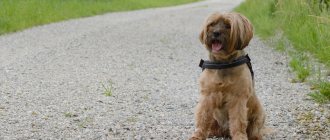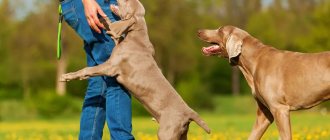When walking their four-legged friends, many owners encounter a problem - the dog pulls on the leash. Some attribute this to curiosity, others do not pay attention, only a few dog owners make efforts to eradicate the behavioral defect. It’s quite easy to do this on your own; you just need to choose the right equipment and spend more time training with your pet. Then walks will bring joy to both.
- 1 Why does a dog pull on a leash?
- 2 How to stop a dog from pulling on a leash: different methods
- 3 Mr. Tail Explains: Master's Mistakes
- 4 Correct collar
- 5 Education and training 5.1 Puppy training
- 5.2 Retraining an old dog
Why does the dog pull on the leash?
The reasons for the behavioral defect associated with the fact that the dog pulls on the leash while walking can be different. They depend on the age of the animal, its temperament, upbringing and other factors.
Puppies just starting to explore the wide world may pull on the leash due to:
- desire to explore surrounding objects and smells;
- desire to establish himself as the leader of the pack.
Adult dogs walk on a tight leash to:
- feel like a leader in the situation;
- express protest by ignoring the owner and his commands;
- release accumulated energy;
- escape from factors that cause fear;
- show aggression and show strength in front of other relatives;
- avoid painful sensations when the owner strongly pulls the pet towards him.
If the dog is specially trained, it can pull on the leash in three cases:
- the guide seeks to show the way (for example, Labrador);
- the dog is on the wanted list and has “attacked” the trail (for example, a shepherd dog);
- A representative of the sledding breed acts instinctively.
In addition, the owner himself risks getting a shoulder injury when walking the dog on a tight leash.
Before scolding, let alone causing physical pain to the ward, the owner must analyze his actions and understand the reason for his behavior. Perhaps the problem lies in upbringing. It is worth devoting more time to training and activities with your pet.
The owner can acquire the necessary knowledge and skills by reading the works of the famous Norwegian dog handler Tyrid Rugos.
How to choose the right walking accessories for your pet?
The basic equipment for dogs is something like this:
- Collar. It is better to give preference to soft, leather.
- Leash. You need several: a short one for training a dog - a “handle” up to 50 cm, a medium length for walking - up to 3 meters, one or two spare ones in case the main one is lost.
- Muzzle. In urban areas, any breed must be in it. The best muzzles are leather, allowing the animal to breathe with an open mouth.
Additional accessories that your pet may need:
- Noose chain. The good thing is that it can be fixed either with a noose or with a regular collar. The latter is suitable for large dogs for daily walking.
- Parthos. In other words, a strict collar or “strainer”. Used under the strict supervision of a professional dog handler, walking on it is prohibited.
- A harness is equipment necessary for some activities (running, cycling or dog sledding). It is used when practicing PCL skills, and is worn on dogs older than nine months of age.
- Roulette. In extreme cases, it can be used to breed a representative of a small breed. For large dogs, such a “leash” is not appropriate, because the pet is capable of breaking it.
- Ringovka. Exhibition chain and thin leather or latex leash. Essential for four-legged animals visiting exhibitions. More precisely, individual large breeds.
There are various devices that make walking your dog easier. But if the pet trusts its owner, there is mutual understanding and an attentive, sensitive attitude on the part of the latter, there is no need to use them.
Video: how to stop a dog from pulling on a leash? Trained by Antoine Najarian
How to stop a dog from pulling on a leash: different methods
To correct the dog’s behavior, experts recommend abandoning the tape measure and replacing it with a regular leash 3-5 m long. Fix it in two positions, when the pet is close or far away for the entire length. The collar chosen is simple, wide and comfortable, without additional functions. A palm should be placed between it and the neck so that the dog can breathe calmly. You can also use a harness with a carabiner fastening at the front or a special muzzle (halter). Both of these ammunition will force the pet to pay attention to the owner when trying to get ahead.
For training, choose places where there are no external stimuli (cats, cars, people, other dogs). The first lessons should not be long and tiring. Gradually, the time is increased, the locations are changed to others, with the presence of distractions.
The route must be new each time so that the dog does not know it and tries to stay near the owner. If she tries to go her own way, the owner stops abruptly and waits for the pet to approach him, or changes direction. You can walk like a snake, a figure eight, or circles around the site.
Education should be based on praise so that the dog does not have the desire to move away from the owner. Restrictions on freedom, prohibitions, and swearing can provoke an animal to escape. This attraction will lead to the dog constantly walking on a tight leash or gnawing on it in order to free himself.
An alternative method of training would be to train your pet to respond to a clicker (a special device that makes clicking sounds). Each completed exercise or command is followed by a click and a treat. Thus, he will develop an associative connection: correct behavior - click - treat.
On the street, you need to stay in front of the animal so that it tries to follow. When the dog reaches the owner, a familiar sound signal and a treat will follow. But you should not encourage him if he has gone ahead.
Mr. Tail Explains: Master's Mistakes
The behavior of a pet largely depends not only on its temperament and character, but also on the owner. If he is ready to make an effort and work with the dog, then the result will not be long in coming.
When an animal’s mannerisms show aggression, a desire for leadership, and other negative aspects, the owner should analyze his own actions towards his four-legged friend. The leader in a pack is always a person; he should not make concessions to the animal, otherwise the dog will feel like a leader.
Tips for walking your pet to help avoid common mistakes:
- the leash is loosened to the maximum for calm familiarization with the territory;
- changing the direction of movement is always only at the request of the owner;
- undesirable moments in behavior (overexcitement, barking, cowardice, aggression) are not approved, but are not punished; at such moments it is better to distract the dog with a toy or command in order to switch attention;
- The jerk method is used only if its use gives a positive result in behavior and the pet stops pulling the leash, coughing and choking; in case of the opposite effect (constant tension with maximum force), this option is not used.
Why is pulling dangerous?
Walking with a constantly vomiting pet is unpleasant in itself. But when the dog pulls hard on the leash, it also threatens injury for the pet and the owner. So:
- if the pet pulls the ammunition, the person may suffer dislocations of the shoulder, hand, or elbow;
- a tight collar compresses the throat, makes breathing difficult, leading to coughing, wheezing, and suffocation.
Over time, the animal gets used to walking only with a leash that is cracking from tension. He doesn't like it as much as the owner does. But the pet doesn’t see a way out and continues to “pull the strap.”
Correct collar
The dog's equipment should not cause him discomfort. The collar is chosen to be wide so that it does not rub or squeeze the neck; the size and material of the leash depends on the breed and weight of the four-legged friend.
| Accessory | Description |
| Leash | A thick strip of fabric (for example, canvas) with a carabiner for coupling to the collar at one end, and at the other there may be a loop for the owner to hold onto. |
| Roulette | Inside the plastic structure there is a cord with a carabiner, which automatically decreases or lengthens as the pet approaches or moves away. |
| Parfors (strict collar, strict collar) | A metal device with spikes on the inside, which, when the leash is pulled, dig into the animal’s neck. Popular among owners of large breeds (for example, AST, Doberman, etc.). |
| Noose | A thin cord that suffocates the dog when trying to pull the owner along with the leash. Also used for large-sized representatives. |
| Halter | Its structure resembles a muzzle and is used to correct behavior. The pressure is not on the neck, but on the face, due to this the dog does not experience pain. |
| Electroshock (ESH) | The principle of operation is a double impact: the first shock is vibration - warning, the second is a weak discharge of electricity. |
| Harness | It is fixed on the dog's body, its convenient fold allows you to control, distribute the load along the back, and does not cause pain or suffocation. Ammunition is popular among sledding breeds (for example, huskies). |
The cutter and shock collar are used only in exceptional cases by professionals, when the animal can be dangerous to others. To prevent this from happening, you should devote time to training and teach your pet commands.
The noose is used for training with an experienced dog handler or under his supervision. Without expert supervision, this type of collar can be harmful to your pet's health. Experts recommend using this method of education in extreme cases. Because dogs respond more to positive things and praise than to scolding and negative influences.
Education and training
All dogs have different personalities and temperaments. Therefore, training is selected individually, based on what influences the four-legged friend (treats, emotions or toys). Below in the article are examples of training for puppies and adult dogs. But the owner should not encourage inappropriate behavior.
Regularly following simple rules will help improve the situation so that the dog does not pull on the leash.
First exercise: as soon as the pet pulls on the leash, stop and wait until he comes up. As practice shows, the method is not effective in all cases. There are dogs that can stand in one place for a long time, waiting for their owner.
Second exercise: when pulling on the leash, sharply command “come to me” and turn around, changing the direction of the path. The dog must react. Using this option, you can also practice other commands, for example, “left”, “right”, “back” and others.
It happens that four-legged friends do not respond to the call. In this case, it is necessary to let go of the leash if the owner is sure that the dog will not run away, or choose a long one. The owner walks in the other direction until the student pays attention and catches up with him.
If there is no reaction to leaving, you should hide behind a tree, corner of the house or other secluded place. When the dog notices the owner's absence, it will panic. The main thing is not to leave her unattended.
The exercise should not be used too often on adult animals. It is not entirely true to the pet, but it is still capable of teaching it to stay close to its owner. For puppies, such a situation will become stressful, so they are trained using a different method.
Puppy training
Problems in the behavior of babies can lead to health complications in an adult dog. Training should begin upon reaching 3-4 months of age, when the puppy begins to go outside. For fruitful work, the owner must follow the rules:
- before starting training, give the baby time to familiarize himself with the territory, external stimuli, play with the baby so that he is calmer;
- training should be carried out daily, initially they should take no more than 5 minutes, gradually increase the time to half an hour;
- For each correctly performed exercise, verbally praise the baby, handing over a treat once for three approvals.
Home workouts will also be beneficial. A technique developed by a famous US dog handler is suitable for children.
The owner fastens the dog and makes him sit next to him. He chooses his favorite toy and begins to tease the puppy, then throws it slightly forward or to the side. Together they go after the object. If the puppy tries to run and pulls on the leash, the owner returns to the starting point with the baby and shows his disapproval with emotions (frustration, shaking his head, sighs) that he will have to start over. This should continue until the owner and dog reach the object together.
If a treat is used instead of a toy to attract attention, it should be placed in a food bowl. Otherwise, the pet will think that it can be picked up from the floor or ground.
Retraining an old dog
The process is longer, but there is no need to retreat. The pet must realize and accept that the leader of the pack is his master. It will take at least a month to retrain. The main thing is not to give up and continue training diligently. If they do not bring results and the behavior does not change, you should contact a professional dog handler who can find an approach.
You can correct the behavior of an adult dog using two methods based on practicing the “near” command.
The first is with the use of force. When the pet starts to pull on the leash, the owner stops it with a sharp jerk and gives a command. In most cases, dogs quickly understand what causes this behavior.
The second is to hone the command at home with the help of a toy or treat. After a walk, when the dog is able to concentrate, the owner calls it to him and gives the command “near”. Together they walk in different directions of the room. In this case, the owner’s hand with a tasty morsel or toy is located just above the pet’s muzzle.
What should not be done during behavior correction?
The main task of the handler is to wean the dog from tugging and pulling on the leash. Prohibited methods look like this:
- Violence against animals, constant shouting, swearing and a mechanical method of education. All actions are performed only if the pet is motivated and has positive reinforcement. That is, the pet must want to complete the task, understand that a reward awaits him for correct behavior, and strive to receive one.
- Using a tape measure. This is not exactly a method of correcting behavior, but rather ammunition for a four-legged animal. The fact is that while walking on it, the animal gets used to being at a distance from the owner. The tape measure is designed in such a way that it initially allows the pet to pull it.
- Drop the leash and run away from your student. It is especially dangerous to practice this action on puppies, because they will become frightened and may take actions that are far from the owner’s expectations. Some adult dogs are so independent that they will ignore the owner and run in the opposite direction, while others will remain standing in place, waiting for the person to get tired of the new “game”.
- Pretend to be a tree. This exercise means stopping while the dog is pulling on the leash and waiting for it to return to the left leg. A pointless exercise, because you can stand like this for an hour, or two, or longer. In addition, the four-legged dog can jerk the leash sharply, which will lead to injury to the owner (at best). The worst case scenario is that the pet will break loose and run away, and then you will have to look for it.
On the Internet you can find recommendations on the use of this or that ammunition that helps correct dog behavior. Halters and bridles actually play a significant role in this. Only adjustment occurs at the expense of causing pain to the animal. The best way to obedience a pet is contact and trust between him and the owner.











